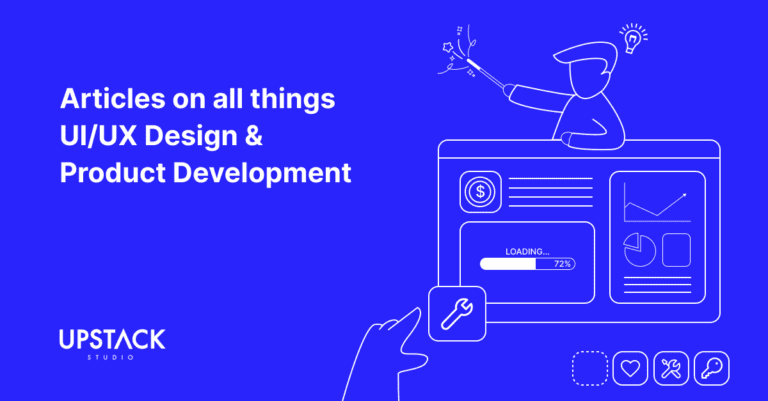E-learning has transformed education, with platforms like Khan Academy making high-quality learning accessible to millions.

This guide explores the steps to create an app inspired by Khan Academy, focusing on:
- understanding users
- defining objectives
- incorporating essential features
Let’s begin.
Identifying Your Target Users
Understanding your target users is crucial for the success of your e-learning app.

Whether catering to children, students, or casual learners, knowing your users will help you tailor your app’s content, design, and features.
To do this, you need to create a user persona, which we explain at length in our five essential elements for a product roadmap.
Once you know your users, you can start tailoring your app to meet their needs.
Learning Preferences, Goals, and Challenges
Different groups of people learn differently, but those within the same group often face the same problems and share the same goals.

Consider the following when identifying your target users:
- Learning Preferences: Are your users visual learners, auditory learners, or do they prefer reading?
- Learning Goals: What are your users aiming to achieve? Are they seeking to pass exams, learn a new skill, or gain knowledge in a specific field?
- Challenges: What obstacles might your users face? This could include limited time, lack of motivation, or difficulty understanding complex topics.
Aligning Content with Educational Standards
Align your content with recognized educational standards to enhance credibility and ensure your app is a valuable resource.
| Learning Objective | Standard Alignment | Content Type |
| Basic Math Skills | Common Core Math Standards | Video Lessons |
| Introductory Programming | CSTA K-12 Computer Science Standards | Interactive Coding Exercises |
Key Features and Design Principles
Incorporating key features and adhering to established user interface design principles will make your e-learning app stand out.

Some key features common to e-learning apps include:
- Video Lessons: Provide high-quality video content that explains concepts clearly.
- Interactive Quizzes: Engage users with quizzes to test their understanding.
- Progress Tracking: Allow users to track progress and set learning goals.
- Discussion Forums: Enable peer-to-peer interaction and community support.
User-Centered Design Principles
For an effective e-learning app, ensure intuitive navigation so users easily find what they need.

Implement responsive design to guarantee compatibility across various devices and maintain a minimalistic interface that keeps the design clean and focused on learning.
Personalized and Adaptive Learning
Personalized learning tailors the educational experience to individual users, adapting to their pace, preferences, and performance.
Adaptive Learning Algorithms
Implement adaptive learning algorithms to adjust content difficulty based on user performance, offering a customized learning experience.
The Role of Multimedia Elements
Multimedia elements like videos, animations, and interactive simulations can enhance learning engagement and effectiveness.
Incorporating Diverse Content Types
Khan Academy’s greatest strengths ithe huge range of topics it manages to cover in various media modalities, all while maintaining a high standard.

Some of the cool options they offer include:
- Videos: Explain complex concepts visually.
- Animations: Illustrate dynamic processes and systems.
- Interactive Simulations: Allow users to experiment with concepts in a controlled environment.
Without sacrificing quality of content, aim to provide as much variety as you can to users.
Implementing Effective Feedback and Assessment
Timely and constructive feedback is essential for helping users improve and stay motivated.

This means providing a wide variety of quizzes and tests that reinforce and remind users of learned content such as:
- Immediate Feedback: Helps users learn from mistakes instantly.
- Detailed Explanations: Offers insights into why certain answers are correct or incorrect.
- Performance Analytics: Allows users to track their progress and identify areas for improvement.
Designing for Accessibility
Ensuring your e-learning app is accessible to all users, including those with disabilities, is crucial.
Key Accessibility Features
- Text-to-Speech: For visually impaired users.
- Subtitles and Transcripts: For hearing-impaired users.
- Keyboard Navigation: Ensure users can navigate the app without a mouse.
Exploring Monetization Models
App monetization is critical for developing a sustainable e-learning app. Various models can be explored depending on your target audience and business goals.
- Freemium Model: Offer basic content for free and charge for premium features.
- Subscription Model: Charge users a recurring fee for access to content.
- In-App Purchases: Allow users to buy additional content or features.
We can’t use Khan Academy as a reference as it’s a non-profit organization, but there are tons of other e learning apps that generate significant amounts of revenue such as Duolingo.

The app, which made over USD 500 million in 2023, makes money via its Super Duolingo subscription which offers premium features like offline access, ad-free lessons, and progress tracking.
Testing, Iteration, and User Feedback
Continuous app testing and iteration are key to the success of your app.

Gathering user feedback allows you to make data-driven decisions and improve the app over time.
- Beta Testing: Involve a group of users to test the app before launch.
- A/B Testing: Compare different versions of a feature to see which performs better.
Conclusion
Creating an e-learning app like Khan Academy requires a deep understanding of your users, clear learning objectives, and a commitment to quality and accessibility.

By incorporating the key features, design principles, and monetization models discussed in this guide, you can develop an app that educates, engages, and inspires learners worldwide.
All the best 🙂
Hey there stranger, thanks for reading all the way to the end. Consider joining our mailing list for a one-stop resource on everything from micro SaaS validation all the way to execution and promotion. Get a nifty list of questions to ask app developers when you sign up!
Download this template now so you know exactly what to ask App Development Agencies! Let us know where should we send it through the form below.


